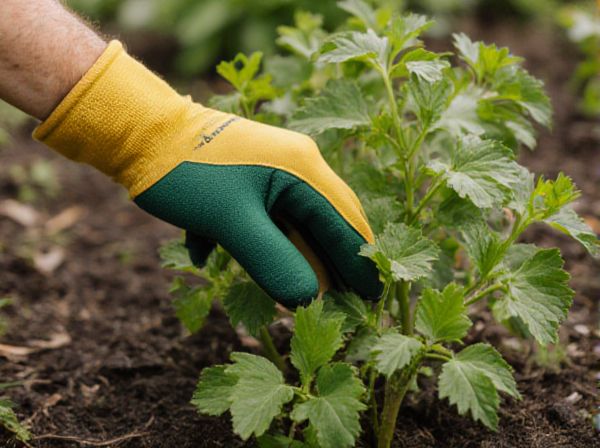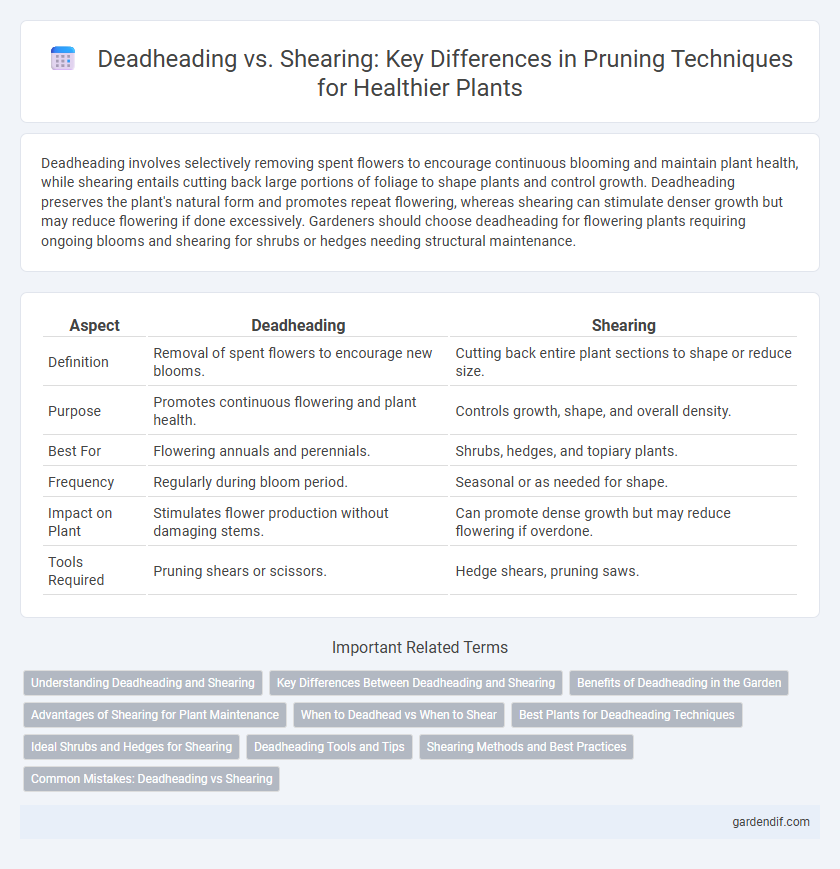
Deadheading vs shearing Illustration
Deadheading involves selectively removing spent flowers to encourage continuous blooming and maintain plant health, while shearing entails cutting back large portions of foliage to shape plants and control growth. Deadheading preserves the plant's natural form and promotes repeat flowering, whereas shearing can stimulate denser growth but may reduce flowering if done excessively. Gardeners should choose deadheading for flowering plants requiring ongoing blooms and shearing for shrubs or hedges needing structural maintenance.
Table of Comparison
| Aspect | Deadheading | Shearing |
|---|---|---|
| Definition | Removal of spent flowers to encourage new blooms. | Cutting back entire plant sections to shape or reduce size. |
| Purpose | Promotes continuous flowering and plant health. | Controls growth, shape, and overall density. |
| Best For | Flowering annuals and perennials. | Shrubs, hedges, and topiary plants. |
| Frequency | Regularly during bloom period. | Seasonal or as needed for shape. |
| Impact on Plant | Stimulates flower production without damaging stems. | Can promote dense growth but may reduce flowering if overdone. |
| Tools Required | Pruning shears or scissors. | Hedge shears, pruning saws. |
Understanding Deadheading and Shearing
Deadheading involves selectively removing spent flowers to encourage continuous blooming and maintain plant health, primarily practiced on flowering shrubs and perennials. Shearing is a more aggressive pruning technique that trims the entire plant surface to shape and control size, commonly used for hedges and formal topiaries. Understanding the distinct purposes and methods of deadheading and shearing helps optimize plant growth and aesthetic appeal in garden maintenance.
Key Differences Between Deadheading and Shearing
Deadheading involves selectively removing spent flowers to promote continuous blooming and prevent seed formation, primarily benefiting flowering plants. Shearing is the uniform trimming of plant foliage to maintain shape, control size, and encourage dense growth, commonly applied to hedges and shrubs. While deadheading targets reproductive parts to extend flowering, shearing focuses on structural maintenance and overall plant form.
Benefits of Deadheading in the Garden
Deadheading promotes continuous blooming by removing spent flowers, which redirects the plant's energy toward new growth instead of seed production. This practice improves the overall appearance of garden plants, maintaining a tidy and vibrant look throughout the growing season. It also helps prevent disease by reducing decay and promoting better air circulation around the plants.
Advantages of Shearing for Plant Maintenance
Shearing promotes dense and uniform growth by cutting back entire branches, improving the overall shape and health of shrubs and hedges. It reduces the risk of disease by removing older, less vigorous wood and encourages new, vigorous shoots that enhance plant vitality. This method is especially effective for maintaining formal landscapes and providing consistent year-round structure.
When to Deadhead vs When to Shear
Deadheading is best performed during the active blooming phase to remove spent flowers, encouraging continuous blooming and preventing seed formation. Shearing is typically done at the end of the growing season or before new growth begins to reshape shrubs and maintain compact form. Timing deadheading focuses on promoting flower production, whereas shearing prioritizes structural maintenance and overall plant health.
Best Plants for Deadheading Techniques
Best plants for deadheading techniques include roses, petunias, and marigolds, as these species benefit from removal of spent blooms to encourage prolonged flowering. Deadheading targets individual wilted flowers, enhancing plant health and bloom production, unlike shearing which involves bulk trimming of foliage for shaping. Effective deadheading improves air circulation and reduces disease risk in flowering plants optimized for repeated bloom cycles.
Ideal Shrubs and Hedges for Shearing
Ideal shrubs and hedges for shearing include boxwood, privet, yew, and holly due to their dense foliage and ability to maintain shape after uniform cutting. These species respond well to shearing, promoting thick growth and clean, formal lines essential in topiary and structured garden designs. Deadheading, in contrast, suits flowering plants like roses or hydrangeas that benefit from removing spent blooms rather than uniform trimming.
Deadheading Tools and Tips
Deadheading involves removing spent flowers to encourage continuous blooming, and essential tools include hand pruners, garden scissors, and finger pinching for delicate plants. Using sharp, clean tools minimizes damage and reduces disease risk, while cutting just above a leaf node or lateral bud promotes healthy new growth. Regular deadheading not only improves plant appearance but also extends flowering periods for annuals and perennials.
Shearing Methods and Best Practices
Shearing involves selectively trimming plant foliage to maintain shape and promote healthy growth, primarily used on hedges and shrubs such as boxwood and privet. Best practices include using sharp, clean tools to avoid damage, making cuts at a slight angle to reduce water retention, and timing shearing during the active growing season to encourage denser foliage development. Regular shearing intervals, typically every 4 to 6 weeks in spring and summer, help achieve uniform shapes while preventing stress and disease in plants.
Common Mistakes: Deadheading vs Shearing
Common mistakes in pruning often involve confusing deadheading with shearing, which serve different purposes in plant care. Deadheading removes spent flowers to encourage continuous blooming, while shearing involves trimming foliage to shape plants and control growth. Misapplying shearing instead of deadheading can stress plants and reduce flowering potential, highlighting the importance of understanding their distinct roles.
Deadheading vs shearing Infographic

 gardendif.com
gardendif.com